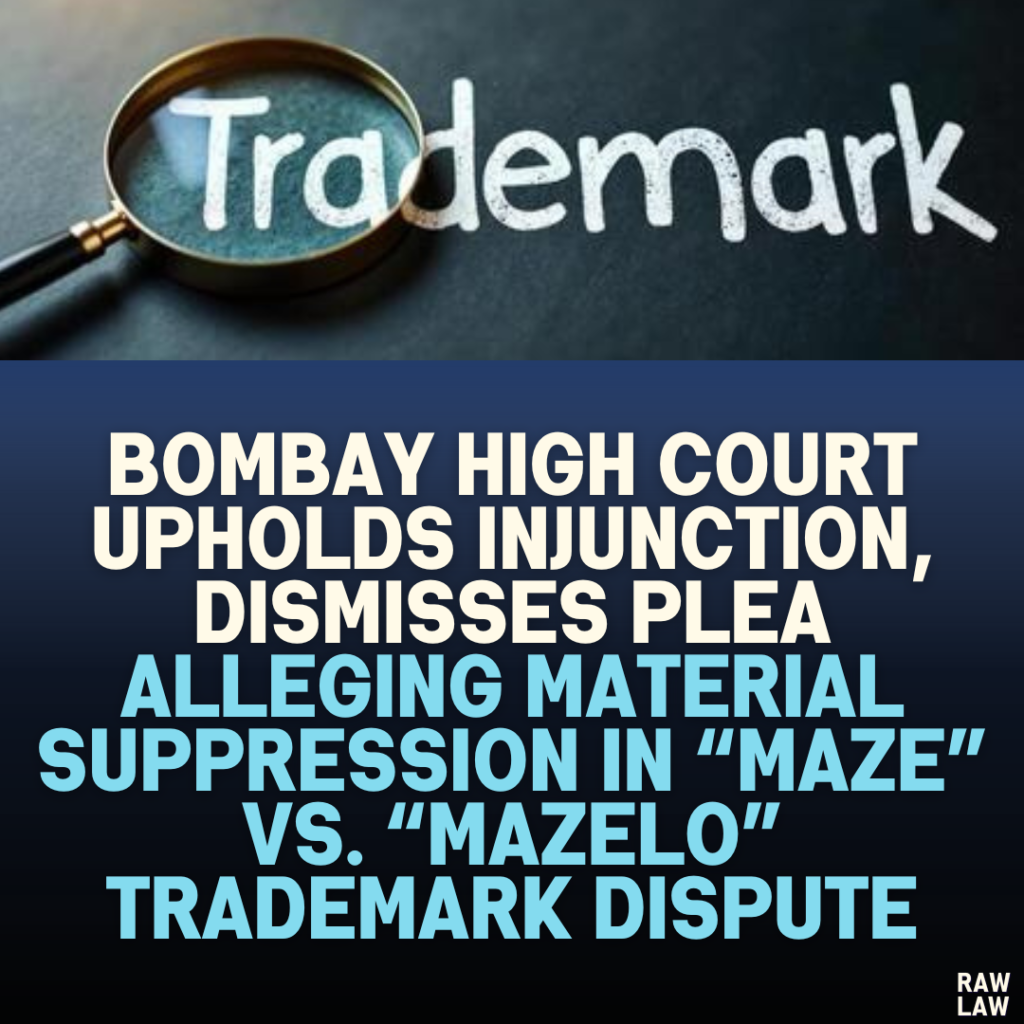Court’s Decision:
The Bombay High Court dismissed the application filed by the defendants to vacate an ex-parte ad-interim injunction granted to the plaintiffs, which restrained the defendants from using the trademark “MAZE” for their confectionery products. The defendants argued that the plaintiffs had suppressed material facts regarding the prior use and registration of the “MAZE” mark and had not disclosed relevant proceedings before the Trademark Registry. The court found no material suppression or misleading statements by the plaintiffs that would warrant vacating the injunction.
Facts:
The plaintiffs are the registered owners of the trademark “MAZELO” for confectionery products. They filed a suit alleging that the defendants were passing off their product as “MAZELO” through the use of the similar-sounding mark “MAZE.” The plaintiffs sought and obtained an ex-parte ad-interim injunction restraining the defendants from using the “MAZE” mark. Subsequently, the defendants filed an application under Order XXXIX Rule 4 of the Code of Civil Procedure (CPC) to vacate the injunction, claiming the plaintiffs had misrepresented facts and omitted significant information regarding prior use and registration of “MAZE” by the defendants.
Issues:
- Whether the plaintiffs had knowingly suppressed material facts or made misleading statements in obtaining the ex-parte injunction.
- Whether the prior use and registration of the “MAZE” mark by the defendants and their public advertisements were material facts that the plaintiffs should have disclosed.
Petitioner’s Arguments:
The plaintiffs argued that their trademark “MAZELO” was coined and inherently distinctive. They claimed they only became aware of the defendants’ “MAZE” mark recently and had not suppressed any material facts. The plaintiffs contended that their duty of disclosure was met, as they had referenced ongoing rectification proceedings against the “MAZE” mark in the Trademark Registry. Furthermore, they asserted that the defendants’ arguments centered on issues better suited for a full hearing of the interim relief application under Order XXXIX Rules 1 and 2 of the CPC, rather than the current application under Rule 4.
Respondent’s Arguments:
The defendants argued that the plaintiffs had knowledge of the “MAZE” mark as early as 2019 and deliberately misrepresented their lack of awareness. They contended that the plaintiffs’ failure to disclose the full history of proceedings before the Trademark Registry and the prior use of “MAZE” constituted material suppression. The defendants further argued that the plaintiffs’ own documents, including invoices and social media posts, showed they were aware of the defendants’ mark long before filing the suit.
Analysis of the Law:
Under Order XXXIX Rule 4, the CPC allows for the discharge or setting aside of ex-parte orders if it is shown that the applicant knowingly made false or misleading statements. The court reviewed whether the plaintiffs had indeed suppressed material facts or made misleading claims. The court reiterated the importance of full and accurate disclosure in ex-parte proceedings but emphasized that the burden of proof lies on the party seeking to vacate the injunction to show deliberate suppression or misrepresentation.
Precedent Analysis:
The court referred to its previous decisions, including Laser Shaving (India) Pvt. Ltd. and Sabmiller India Ltd. vs. Jagpin Breweries Ltd., emphasizing that non-disclosure must be of facts directly material to the issue at hand. The court distinguished these cases based on the facts presented by the defendants, concluding that the defendants failed to show any deliberate suppression or concealment of material information.
Court’s Reasoning:
The court found no evidence that the plaintiffs had made misleading statements or suppressed facts. The plaintiffs had acknowledged the rectification proceedings related to the “MAZE” mark, thus meeting their duty of disclosure. Additionally, the court noted that the defendants had not substantiated their claims regarding the plaintiffs’ knowledge of the “MAZE” mark prior to September 2023 with concrete evidence. The court also stated that the explanation for coining the “MAZELO” mark provided in the plaintiffs’ rectification application did not render the mark descriptive or generic, as claimed by the defendants.
Conclusion:
The court dismissed the defendants’ application, concluding that there was no material suppression or misrepresentation on the part of the plaintiffs that would justify vacating the ex-parte injunction. The court upheld the injunction, finding that the defendants had failed to demonstrate that the plaintiffs had violated their duty of full and candid disclosure.
Implications:
This ruling underscores the strict standards required to vacate ex-parte injunctions in intellectual property disputes, particularly concerning the duty of disclosure. The decision reinforces the principle that parties seeking to vacate injunctions must clearly establish deliberate non-disclosure or misrepresentation of facts material to the case. The court’s decision highlights the importance of transparency in trademark disputes and offers guidance on the handling of coined versus descriptive marks in infringement and passing-off claims.



